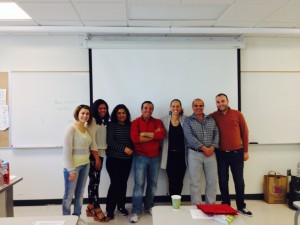Interview with upcoming CultureFest Performer Laura Kina
Multiracial Network Blog
2014-03-07
To start us off, we have an interview from our CultureFest performer Laura Kina! As can also be found on her website (http://www.laurakina.com/) Laura is an artist and scholar who focuses “on the fluidity of cultural difference and the slipperiness of identity”. With subjects ranging from Asian American history to mixed race representation, her work blends autobiography with artwork, breaking down stories and putting them back together. Come see her perform “Hapa Yonsei Uchinanchu” her “talk story” about her Okinawan family history in Hawaii and her multiracial identity while showing images of her recent oil paintings and much more! Check her out at CultureFest on Sunday March 30 from 6-9pm in the Convention Center, as part of CelebrACPA immediately after the opening ceremony.
- Where and how do you get your inspiration for your art?
- Do you have a favorite piece of art you’ve created? Why?
[I’m going to answer both questions at once below]
My artwork usually starts out with an autobiographical impulse and series of questions and then develops as I gather source materials and do field research. For example, in my current exhibition Blue Hawaiʻi, which is on view through March 27, 2014 at the University of Memphis Fogelman Galleries of Contemporary Art, I initially traveled to Hawaiʻi in 2009 to look at community and family photos and interview elders in my dad’s Pi’ihonua sugarcane plantation community on the Big Island of Hawaiʻi as well as other Nisei (2nd generation) and Sansei (3rd generation) from nearby plantations. I grew up in a small Norwegian town called Poulsbo, WA and aside from my dad and my grandma Kina, I was pretty cut off from this part of my heritage. We’d go back as tourists and grew up eating Spam Musubi but I wanted to learn about the real Hawaiʻi and what it means to be Uchinanchu (Okinawan)…
…4. What was the process of creating, organizing, and implementing the Critical Mixed Race Studies Conference?
I went to this 2008 leadership retreat with my DePaul colleague Camilla Fojas. She had just published her co-edited book Mixed Race Hollywood (NYU Press, 2008) with Mary Beltrán and I was beginning to teach a class called “Mixed Race Art and Identity.” We were doing a workshop activity where you put post-it notes up on a wall with where you see yourself in five years in the multiracial movement and what you want to work on. After everyone had their dreams on the wall, we moved out post-it notes around to align with each other. It was out of this activity and other theater and drawing activities that Camilla Fojas, and Wei Ming Dariotis from San Francisco State University, and I had the very practical idea to work towards legitimizing multiracial studies in an academic context. Our hope was to found an association for critical mixed race studies. We used the word “critical” from “critical race” theory to point towards systems of racialization and used the “mixed race” (with no hyphen) from what was being used at the time (as opposed to “multiracial”) to define the movement. The no hyphen comes from us ditching hyphenated identities in Asian America. I know this is confusing when “mixed-race” is used as a compound modifier! We sat down and hammered out a definition, which we are still using today for Critical Mixed Race Studies:
Critical Mixed Race Studies is the transracial, transdisciplinary, and transnational critical analysis of the institutionalization of social, cultural, and political orders based on dominant conceptions of race. CMRS emphasizes the mutability of race and the porosity of racial boundaries in order to critique processes of racialization and social stratification based on race. CMRS addresses local and global systemic injustices rooted in systems of racialization.
But before we could found an association we figured we should start small by organizing a conference. We sent out a call for papers in 2009 and by the time the inaugural conference “Emerging Paradigms in Critical Mixed Race Studies” took shape in November 2010 we had over 200 paper submissions and 430 people attended. What was unique about this first conference is that it wasn’t a student conference, as most large-scale meetings on multiraciality had been up to this point. It was an academic conference but it also recognized the movements community roots and included arts and community programming and it drew national and international participation. For our subsequent 2012 conference “What is Critical Mixed Race Studies?”, which over 450 people attended, we sought to keep this core spirit but wished to professionalize the process to ensure peer review but to also create a sustainable process for the conference can keep going. Camilla Fojas worked with an external panel of reviewers to select the papers and I partnered with Mixed Roots Stories to organize arts programming. We are doing this again for the Nov 13-15, 2014 conference “Global Mixed Race.”
To read in detail about the history of multiracial studies in the U.S. and the founding of Critical Mixed Race Studies, please read the inaugural issue of the Journal of Critical Mixed Race Studies article “Emerging Paradigms in Critical Mixed Race Studies” by G. Reginald Daniel, Laura Kina, Wei Ming Dariotis, and Camilla Fojas…
Read the entire interview here.



